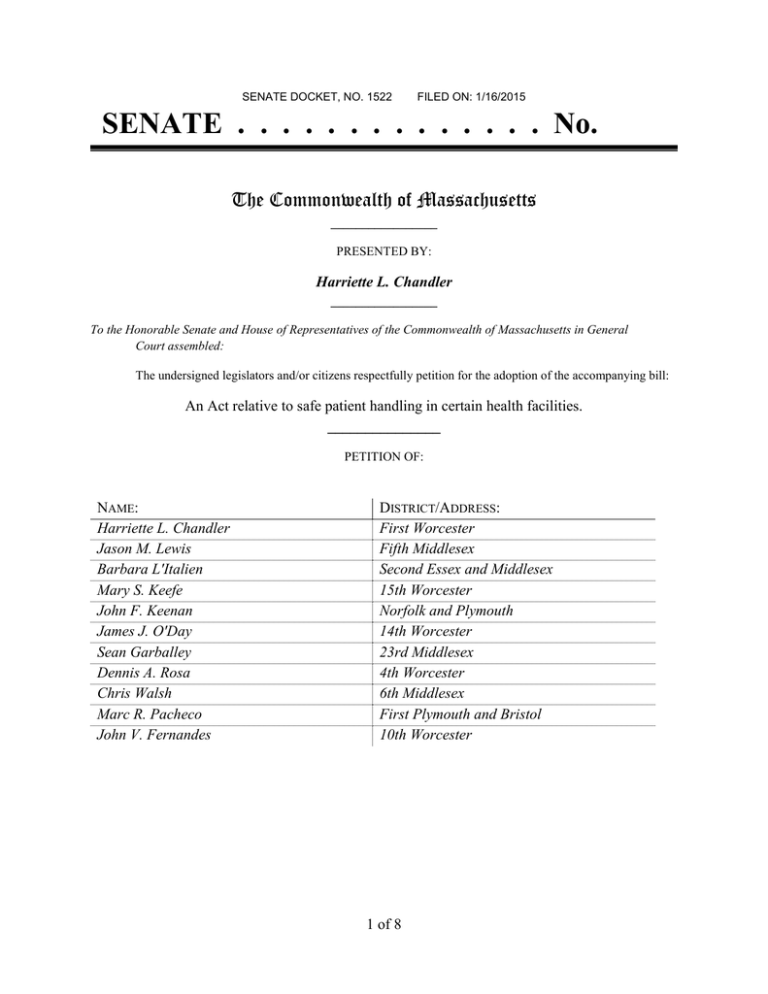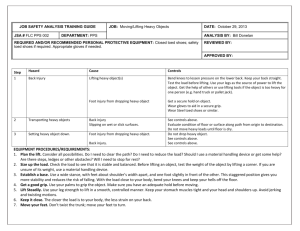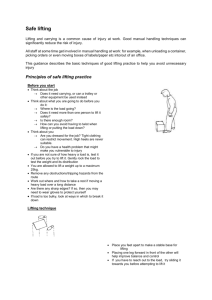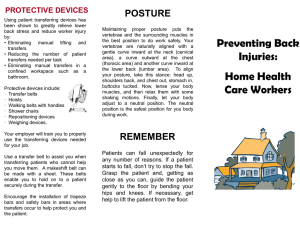MA Safe Patient Handling bill 2015
advertisement

SENATE DOCKET, NO. 1522 FILED ON: 1/16/2015 SENATE . . . . . . . . . . . . . . No. The Commonwealth of Massachusetts _________________ PRESENTED BY: Harriette L. Chandler _________________ To the Honorable Senate and House of Representatives of the Commonwealth of Massachusetts in General Court assembled: The undersigned legislators and/or citizens respectfully petition for the adoption of the accompanying bill: An Act relative to safe patient handling in certain health facilities. _______________ PETITION OF: NAME: Harriette L. Chandler Jason M. Lewis Barbara L'Italien Mary S. Keefe John F. Keenan James J. O'Day Sean Garballey Dennis A. Rosa Chris Walsh Marc R. Pacheco John V. Fernandes DISTRICT/ADDRESS: First Worcester Fifth Middlesex Second Essex and Middlesex 15th Worcester Norfolk and Plymouth 14th Worcester 23rd Middlesex 4th Worcester 6th Middlesex First Plymouth and Bristol 10th Worcester 1 of 8 SENATE DOCKET, NO. 1522 FILED ON: 1/16/2015 SENATE . . . . . . . . . . . . . . No. [Pin Slip] [SIMILAR MATTER FILED IN PREVIOUS SESSION SEE SENATE, NO. 991 OF 2013-2014.] The Commonwealth of Massachusetts _______________ In the One Hundred and Eighty-Ninth General Court (2015-2016) _______________ An Act relative to safe patient handling in certain health facilities. Be it enacted by the Senate and House of Representatives in General Court assembled, and by the authority of the same, as follows: 1 2 3 4 SECTION 1. Chapter 111 of the General Laws, as appearing in the 2012 Official Edition, is hereby amended by inserting after section 91C the following section:Section 91D. As used in this section, the following words, shall, unless the context clearly requires otherwise, have the following meanings:- 5 “Acute-care hospital”, any hospital licensed pursuant to sections 51 and 52 and the 6 teaching hospital of the university of Massachusetts medical school, which contains a majority of 7 medical-surgical, pediatric, obstetric, and maternity beds, as defined by the department. 8 “Department”, the department of public health. 9 “Health care facility”, any acute care hospital as defined in section (a), any licensed 10 private, public or state-owned and operated general acute care rehabilitation hospital or unit, any 2 of 8 11 licensed private, public or state-owned and operated general acute care psychiatric hospital or 12 unit, any nursing home as defined in section 71 and any long term care facility as defined in 13 section 71. 14 15 “Health care worker”, any health facility personnel or lift team member who lifts, transfers or repositions patients or equipment. 16 “Hospital”, any institution, however named, whether conducted for charity or for profit, 17 which is advertised, announced, established or maintained for the purpose of caring for persons 18 admitted thereto for diagnosis, medical, surgical or restorative treatment which is rendered 19 within said institution. 20 “Lift team”, health care facility employees specially trained to handle patient lifts, 21 transfers and repositioning using lifting equipment when appropriate and precluded from 22 performing other duties. 23 “Lifting and transferring process”, a system whereby patients and situations are identified 24 based on the potential risk of injury to the patient and/or health care worker from lifting, 25 transferring or moving that patient. 26 “Long term care facility ”, any institution, however named, whether conducted for charity 27 or profit, which is advertised, announced or maintained for the express or implied purpose of 28 caring for four or more persons admitted thereto for nursing or convalescent care, as defined in 29 section 71. 3 of 8 “Needs assessment”, an evaluation of lift and transfer needs, resources and capabilities 30 31 with recommendations on procedures to be followed and resources available to lift and transfer 32 patients safely. “NIOSH RWL”, 35 pound or current maximum recommended weight lift limit, a 33 34 standard calculated by NIOSH, as explained at http://www.cdc.gov/niosh/94-110.html “Nursing home”, any institution, however name d, whether conducted for charity or 35 36 profit, which is advertised, announced or maintained for the express or implied purpose of caring 37 for four or more persons admitted thereto for nursing or convalescent care, as defined in section 38 71. 39 40 41 “Patient”, an individual who receives health services at a hospital, health care facility, or long term care facility. “Patient care ergonomic evaluation ”, e valuation performed in all direct patient care 42 areas including but not limited to acute care, critical care, rehabilitation, radiology, operating 43 room, urgent care, therapy departments, long term care, outpatient service, etc. following 44 guidance from the OSHA Nursing Home Guidelines, VA Patient Care Ergonomic Guidelines , or 45 other accepted guidance document to identify ergonomic control measures for decreasing risk of 46 injury from patient handling and moving activities. 47 48 49 “Qualified personnel”, person(s) accountable and responsible for the ongoing education and knowledge of patient needs assessment, engineering equipment and patient ergonomics. “Resident”, an individual who resides in a long term care facility. 4 of 8 50 “Safe patient handling policy”, a written statement describing the replacement of manual 51 lifting and transferring of patients and equipment with powered transfer dev ices, lifting devices, 52 and/or lift teams, consistent with a needs assessment and mandating the replacement of manual 53 lifting and transferring of patients with techniques using current patient handling 54 equipment/technology to lift patients unless specifically contraindicated for a patient’s condition 55 or medical status. Such technology/equipment include s , but is not limited to mechanical lifting 56 devices (floor-based & ceiling-mounted), lateral transfer aids, friction reducing devices, fast 57 electric bed s, motorized beds, etc , consistent with clinical unit/area patient care ergonomic 58 evaluation recommendations. Such policy also mandates the use of individual patient handling 59 assessments for each patient/resident requiring assistance. 60 By February 1, 2016 each health care facility shall establish a safe patient handling 61 committee (“committee”) through the creation of a new committee or by assigning the functions 62 of a safe patient handling committee to an existing committee. The purpose of the Committee is 63 to design and recommend the process for implementing a safe patient handling program and to 64 oversee the implementation of the program. At least half the members of the safe patient 65 handling committee shall be frontline non-managerial employees who provide direct care to 66 patients and shall include but not be limited to nurses, laundry, maintenance and infection control 67 employees. 68 By December 1, 2016, the governing body of a hospital or the quality assurance 69 committee of a nursing home shall adopt and ensure implementation of a Safe Patient Handling 70 Program to identify, assess, and develop strategies to control risk of injury to patients and health 71 care workers associated with the lifting, transferring, repositioning, or movement of a patient or 72 equipment, such that manual lifting or transfer of patients is minimized in all cases and 5 of 8 73 eliminated when feasible and manual patient handling or movement of all or most of a patient’s 74 weight is restricted to emergency, life-threatening, or otherwise exception circumstances. As 75 part of this program each facility must: 76 (1) Conduct a comprehensive analysis of the risk of injury to both patients and health 77 care workers posed by the patient handling needs of the patient populations served by the 78 hospital or nursing home and the physical environment in which patient and equipment handling 79 and movement occurs, through: 80 (a) Evaluation of alternative ways to reduce risks associated with patient and equipment 81 handling, including evaluation of equipment and patient care and patient support environments; 82 (b) Conduct of individual patient care ergonomic evaluations in all patient care areas, 83 following guidance from the OSHA Nursing Home Guidelines, VA Patient Care Ergonomic 84 Guidelines, or other accepted guidance document, to identify ergonomic control measures for 85 decreasing risk of injury from patient handling and moving activities; 86 87 (c) Development and implementation of safe patient handling policies based on the needs of all shifts and units of the facility. 88 (2) Identify and list the type and quantity of patient handling equipment and other 89 equipment required on each clinical unit/area and ensure that the purchase and acquisition of all 90 such equipment is incorporated into the Safe Patient Handling Program. Patient handling 91 measures and patient handling equipment/technology shall include but not be limited to 92 mechanical lifting devices (floor-based & ceiling-mounted), lateral transfer aids, friction 93 reducing devices, fast electric beds, and motorized beds . 6 of 8 94 (3) Provide patient handling equipment and/or technology as stipulated in section (2) 95 which is appropriate for each clinical area and patient/resident population, to reduce the risk of 96 injury to direct patient care providers and patients/residents. 97 (4) Provide specialized training in safe patient handling by qualified personnel to all 98 health facility personnel and lift team members who lift, transfer or reposition patients, including 99 but not limited to demonstration of proficiency in safe techniques for lifting or transferring 100 patients and the appropriate use of lifting or transferring devices and equipment. Health care 101 facilities must train staff on policies, equipment and devices at least annually. 102 (5) Develop procedures for health care workers to refuse to perform or be involved in 103 patient and equipment handling or movement that the worker believes in good faith will expose a 104 patient or a nurse to an unacceptable risk of injury without subjecting such worker to disciplinary 105 action. 106 (6) Provide for lift team members, where lift teams are employed, to utilize lifting 107 devices and equipment throughout the health care facility to lift patients unless specifically 108 contraindicated for a patient’s condition or medical status. 109 (7) Prepare an annual performance evaluation report and submit to the governing body or 110 the quality assurance committee on activities related to the identification, assessment, and 111 development of strategies to control risk of injury to patients and health care workers associated 112 with the lifting, transferring, repositioning, or movement of a patient with statistics on the 113 numbers and types of injury to the facilities health care workers and patients; 114 115 (8) Track, publish and disseminate upon request annual injury data including: the financial cost of all safe patient and equipment handling injuries suffered by employees and 7 of 8 116 patients; the nature and cause of injury; date, shift, and unit statistics; cost to the institution and 117 to employees and patients; and outcomes; to the extent permitted by privacy regulations. 118 (9) Identify the type and quantity of patient handling equipment and other equipment 119 required and ensure that the purchase of other acquisition of all such equipment is incorporated 120 into the Safe Patient Handling Program. 121 By January 30, 2016, health care facilities shall complete the acquisition of safe patient 122 handling equipment determined to be required by their safe patient handling committee. Such 123 equipment will include, though not be limited to: (a) at least one readily available lift per unit on 124 each unit where patients will weigh 35 pounds or the current maximum recommended weight lift 125 limit for patients (NIOSH RWL), unless the facility’s safe patient handling committee 126 determines that more lifts are required on the unit; (b) one lift for every ten beds; and/ or (c) 127 equipment for use by lift teams. 128 The development of architectural plans for constructing or remodeling a health care 129 facility or a unit of a health care facility must incorporate patient handling equipment and the 130 construction design needed to accommodate such equipment. 8 of 8





